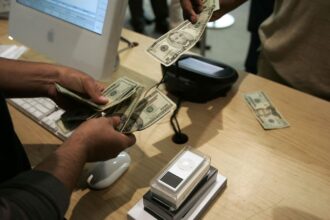Coca Cola is allowed to make new lows? Even though it’s owned in a big way by some of the largest investment funds in the world? Other huge market capitalization brand names are joining the classic soft drink maker on the last week’s new lows list: Pepsi’s been selling off and so has Clorox
CLX
The dumping of the well-known is likely related to the steadily increasing yields on Treasury bonds and notes, a factor often thought to predict the inevitability of a recession. Those who find themselves without jobs are unlikely to be purchasing the usual number of products no matter how much of a brand name.
Here’s the Coca Cola daily price chart:
From the peak of $64 in April to last week’s low of $51.50: that’s a 19.5% drop and the year’s not over yet. Note that the early March low of $57 offered no support once violated in mid-September. Sellers just kept selling. The relative strength index (RSI, below the price chart) reached quite over sold and the stock bounced on Friday.
Berkshire Hathaway of Buffett-and-Munger fame owns a 9.2% share of Coca Cola, not as big as their Apple
AAPL
BLK
The company has a market capitalization of $229 billion.
The daily price chart for Pepsi is here:
Will shares of the other popular sugar, caffeine and carbonated water “soft” drink make a soft landing? Right now, it’s not looking good as the stock took out the February support level on massive Thursday selling. The Friday bounce back is promising — maybe — given the big buying volume and a deeply oversold RSI.
It’s not promising, on the other hand, that the 50-day moving average (the blue line) has crossed below the 200-day moving average (the red line) which is red-circled on the chart.
Market cap for Pepsi is $220 billion.
The Clorox daily price chart looks like this:
Shares of the big consumer products company well-known for its bleach is being unloaded by investors. The April high is $175, last week’s low is $120 — the stock is down from a 2023 peak to the present by about 30%. Note Thursday heavy selling as represented by the reddish bar along the bottom of the price chart.
That the stock’s bounce off of Friday’s low failed to fill Thursday’s gap suggests problems. Note how the 50-day moving average crossed below the 200-day moving average in late September. It may be at least slightly encouraging that the relative strength index is showing a positive divergence to price.
These are just 3 major brand names showing serious selling — others in the consumer products sectors are showing similar dumping. This suggests that investors looking at the economy and interest rates have now moved into the “no soft landing after all” thinking.
Read the full article here










